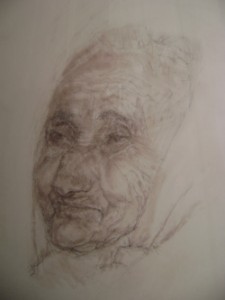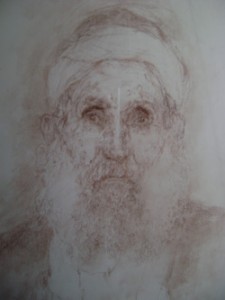Israeli Scene
Life + Style
Letter from Jerusalem: Revelation on Misgav Ladach Street

Thirty years in Jerusalem, I am still looking for Art, a once-vital part of my life in America. Art was forever sublime, a dynamic burrowing into the soul, but held in abeyance from the day I arrived in the Holy Land. Now a persistent itch propels me through the galleries and shops in search of some object that captures and expresses the 3,000 years that envelop me.
The sensation is driven, in part, by the passing of my wife’s mother: The vacuum she left bears down on me, undiminished by passing days. She was like my own grandmother, so much so that I often thought they were sisters, confounded by geography and the curious twisting of history. And underneath it all, I know that my search for Art is a yearning for some impossible fusion of this world and the next.
But my mind is barren, dulled by the cunning landscapes, the flatulent camels, truculent beggars and devastatingly quaint courtyards glutting the market. Where is the Art that will crystallize in one fantastic wash of color all the pain and ecstasy, doubt and wonder that embody life in the holiest of cities? Perhaps it is here, hidden in the dusty recesses of the Jewish Agency building where I am now doing electrical work. Perhaps in the dusty files are some glowing filaments of genius, the souls of the architects, the anguished men who paid astonishing prices to realize the dream of Zion.
On the second floor of the agency is a massive display of photography and text celebrating “100 Years of Jewish Settlement.” Here in black and white, the Jews of the 1880s, the 1920s, ’30s and ’40s swinging their picks, shovels, hammers–a montage of Jewish faces scorched by the desert sun, soaked by the hard rains. Images of joy, hope, sorrow are frozen, forever, on the walls of this gluttonous, bygone building. Around me, phones ringing, doors closing, appointments, consultations, renovations. Where is that living, breathing, immutable work of Art? The itch is not assuaged by the high-tech miracles that abound here.
I leave the Jewish Agency for the Old City. Some odd memory propels me down those narrow, ancient alleyways through the Jewish Quarter to 23 Misgav Ladach Street. There, a carved wood sign hangs above a doorway: “Schwarz–Portraits.” I enter the studio automatically, a Pavlovian response to canvases and images—though, within me, I get an odd tingle that comes from a glance at the portraits on display.

Eli Schwarz sits before the easel, immersed and focused. Is it his posture that persuades me—the way he holds and turns the pencil? Or is it some illusive glow that penetrates my inner eye? I produce a woman’s photograph and I ask if he is able to draw my wife’s mother from this photo.
Schwarz takes the photo of my wife’s mother, Rumiyeh, and I wait there, poised and expectant, wondering if he belongs to the clan of sidewalk artists that scratch out a portrait in 15 minutes. But Schwarz inhabits another planet, and I am not a witness when she emerges beneath his hands. Days later, I return to find her residing on the easel, as I remember her–hard and gentle, dark and open. I cannot define the process that goes on in this studio, though it seems to me a kind of alchemy, revealing a presence that had been shrouded by the stark, immobile lines of the photo.
Eliahu Schwarz–now 88, articulate, a virtuoso in his own right–was born in 1921 in Germany near Frankfurt, son of a fish merchant. At an early age, he was aware of his talent, drawing caricatures of his schoolteachers. Aware, too, of the rabid anti-Semitism devouring Germany. Long before Kristallnacht, his father’s business was shattered by the Brownshirts. Eli’s father wanted to remain in Europe, but his mother prevailed, and the decision to leave Germany was made.
The family arrived in Haifa in 1933. Because they spoke only German, they stayed in a convent of German sisters until they found and rented one room with the chief rabbi of Haifa. Eli quickly adapted to the new land. At 16, he joined the Haganah and, under cover of the Haifa Fire Brigade, he trained with an old World War I rifle. When the War of Independence erupted, he was drafted and went into naval intelligence. But his primary focus was always art. During the Yom Kippur War, the military had him touring the frontlines, giving lectures on the art of caricature.
Schwarz studied at the Bezalel art academy in Jerusalem and the Beaux Arts school and Paris Art Institute; he has had one-man shows in Israel, the United States and Europe. His eye measures and reveals the perverse, the sublime and the absurd. Not only portraits, but his humorous drawings like the Jerusalem street scenes, published in The Jewish Chronicle(published in London), reveal man’s inspiration and exasperations.
“What’s the point,” I ask him, “of all the portraits that you did? Where does it take you?”
“I want to make visible what you can’t see,” he tells me. “Today, I see more than I did 20 years ago.” He talks not about optics but about perception—his half-century trek through the human landscape, trying to penetrate its masks, its illusions; revealing layers that, he says, “often irritate and anger those I draw.” Even now, Schwarz is always seeking the connection between man and the eternal. “Anyone can acquire the technical skills to draw externals,” he says. To grasp and convey an evasive inner reality, however, “is far more than exhausting.”
His media are pencil, watercolor, pen and ink; never oils, which he says are opaque and don’t reveal inner layers. “I need the transparency,” he says, “which shows those layers.” He hands me his book of 53 black-and-white drawings, Hear Our Voices-Women at Prayer–a 10-year study exploring one of the hidden regions of womanhood, concealed even from fathers and husbands.
The women at prayer unfold before me, revealing inner beauty, intensity and absorption in a realm of life far beyond chicken soup and dirty diapers. I compare them to portraits of the Old Dutch masters with their heavy layers of color, the darkness and density, the fleshy molten females. In contrast, Schwarz’s drawings are featherweight, almost an afterthought–as women’s prayer, in Orthodox society, is almost an afterthought. But only for those whose vision of women is blighted. Seeing them through Schwarz’s eyes, I feel the immense power that women possess, the altitudes they penetrate inaccessible to most men.
I watch the artist at work, a man with a clear sharp mind who must be taken full weight. I am reminded of Dali or Picasso–not in appearance or style, but in the love, dedication and intensity that he invests in the works that flow from his hands. After Rumiyeh, a portrait of my wife’s father; later, a portrait of her grandfather. They hang on the wall of my home, immutably themselves–especially her grandfather. Though he had died decades ago, my wife suddenly began to yearn for him. I brought Schwarz a photo showing him in a dark suit, which he stripped off, clothing him in his native Yemenite dress–as if somehow he had penetrated my wife’s memory, together with her yearning.
I learn that others have been here before me: Sir Martin Gilbert, the famous British historian, biographer of Winston Churchill, bought a Schwarz watercolor. Prime Minister David Ben-Gurion saw his drawings when the artist served at naval headquarters. The late Jerusalem Mayor Teddy Kollek lauded Schwarz’s “distinctive and moving portraits…. We are lucky,” he wrote, in one of his letters, “to have this outstanding artist working and living in Jerusalem.”
What touches me, as much as Schwarz’s artistic genius, is that he won’t submit to the vicious stigma of old age. I watch him walk down the alleyways near his studio; in his movement, I can feel the oppressive bulk of the years he carries–but only until he begins to draw: Then I see a maestro of color and form extrapolating life through his Art.
In spite of this, the fault line within me prevails; that dreadful inertia drags me from his studio to continue my search for Art. In spite of the passing decades, I have not cut away the seductive lure of New York’s museums, the endless sea of genius and lunacy that flood the galleries of America. Out of the Old City, I plod through Jerusalem to Shlomzion Ha-Malka Street—both sides packed with galleries. A flood of images assails me: massive paintings in massive frames; tiny miniatures; all hues and shadings up for bid, imploring, enticing–“Buy me. I will bring beauty into your home.
Between the galleries, the traffic roars manic, unceasing. I have reached an end point. In my mind, Eli Schwarz remains as immutable as the portraits he creates, himself a vessel containing endless paradoxes of humanity. I stand there between the deafening traffic and the barrage of gallery art while behind me, in the Old City, that modest studio from which emerged the portraits of my wife’s family as eternal as the Mona Lisa, and at this moment it suddenly gives priceless joy and inspiration.
Contact Eli Schwarz’s studio at 011-972-2-6285-729. To View more of his work visit https://thehope.tripod.com/~Go_Israel/Studio_Schwarz/index.html









 Facebook
Facebook Instagram
Instagram Twitter
Twitter
Gayil Greenberg says
Hi. My name is Gayil greenberg and I am very intrigued by yur work. I have a picture I bought in yur shop years ago of a young girl with braids standing at the Kosel. I’ve attempted to connect with u several times on my trips to Israel. I went to 3 Misgav Ladach but the shop was closed and someone said u moved but they don’t know where. I am coming to Israel the last week in January and I’d love to meet you. Yur paintings have made a big impact on my praying and of my children’s praying. Is it possible to meet u when I come? I will be with all my daughters and they would love to meet u too
Martin Hoffman says
Eli is in an old age home in Jerusalem. The address- Derech Hevron 56. Phone- 02 698811
Robin says
If you find Eliyahu could you please let me know also? I too met him many years ago….May 2009 at his 23 Misgav Ladach studio and would like to reestablis contact with him.
Thank you.
Brigitte Ackermann says
Hallo, mich würde mal interessieren, ob er noch lebt und ob er später Christ würde, also messianische Jude?